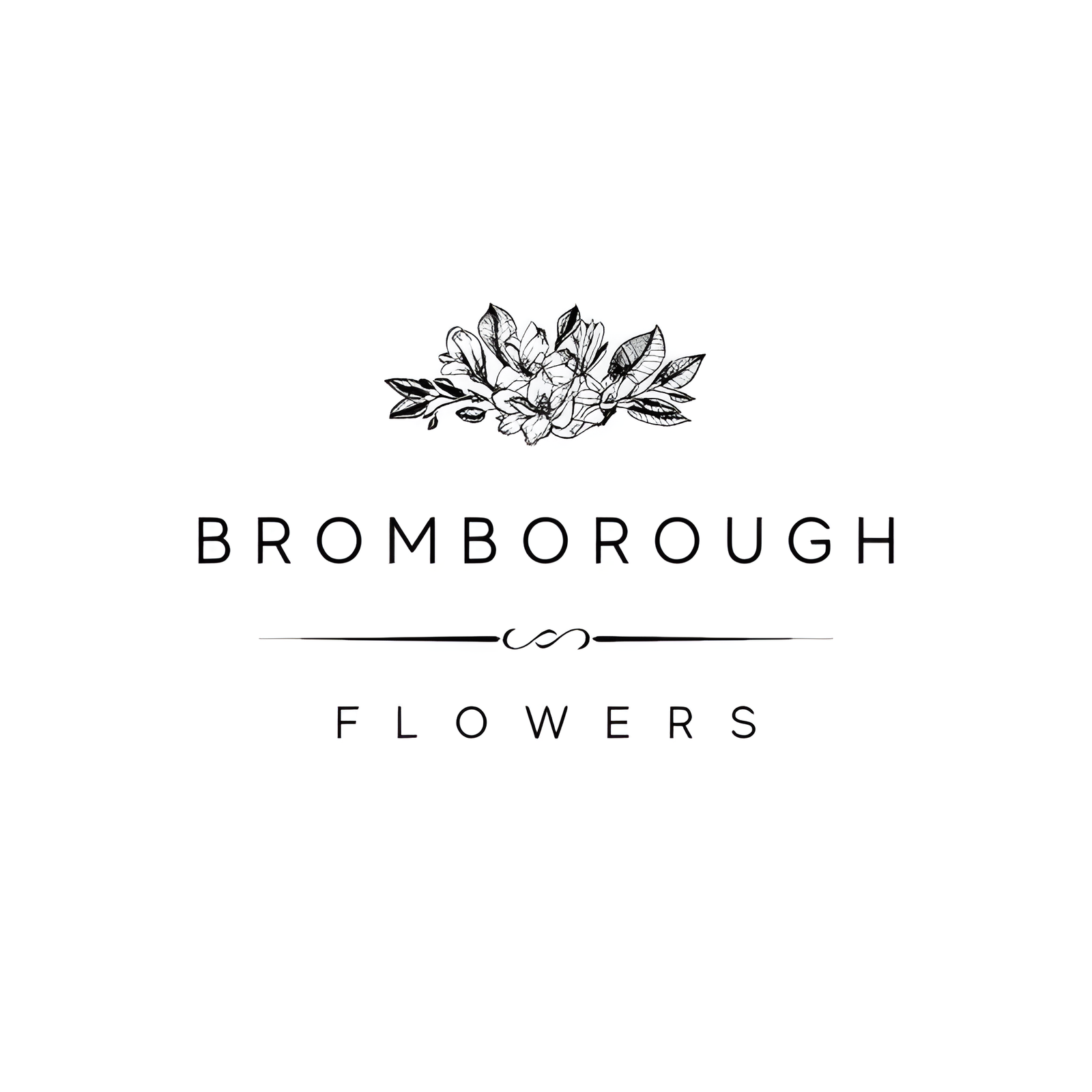When selecting floral arrangements for a wedding, the Crocus emerges as an intriguing option due to its unique blend of symbolism and aesthetic appeal. This member of the iris family, known for its vibrant hues and sophisticated structure, not only enhances the visual appeal but also carries rich cultural connotations of love and prosperity. As we explore the physical characteristics, diverse color varieties, and the botanical background of the Crocus, it becomes clear why this flower is a favored choice for spring nuptials. How does this early bloomer fit into the broader context of wedding florals? Let’s examine further.
Flower Overview
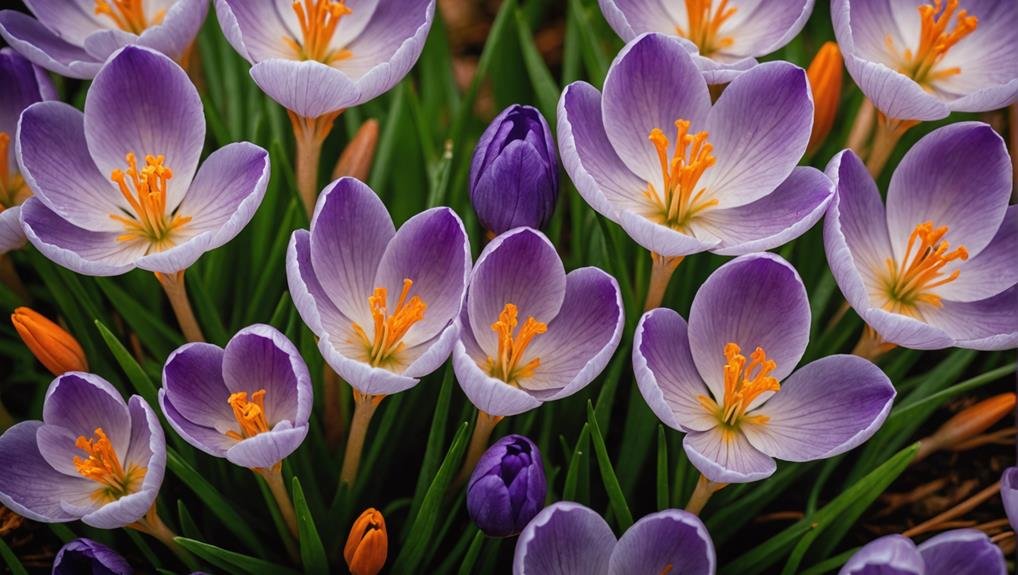
The Crocus, a member of the iris family with approximately 80 species worldwide, is a delicate and versatile flower available in an array of colors such as yellow, mauve, and white. This charming bloom holds significant cultural importance and historical symbolism. In various folklore traditions, the Crocus is often associated with themes of love, happiness, and prosperity, making it an ideal choice for wedding arrangements. Its presence in bridal bouquets and decorations can add a touch of elegance and convey deep, meaningful sentiments.
When incorporating Crocuses into wedding arrangements, it is crucial to follow specific care tips to guarantee their longevity and vibrancy. These flowers thrive in well-drained soil and require moderate watering. To maintain their fresh appearance, it is advisable to keep them in a cool environment away from direct sunlight. Additionally, Crocuses should be handled gently to avoid damaging their delicate petals.
For wedding florists, the versatility of Crocuses offers ample creative potential. They can be combined with other blooms or used as standalone pieces to create visually stunning and symbolic floral displays. Adhering to sustainable practices when sourcing Crocuses also supports the conservation of threatened species.
Physical Description
Crocus flowers, known for their vibrant hues, exhibit long, slender petals that contribute to their delicate and elegant appearance. The petal structure of Crocus blooms is typically cup-shaped, forming a beautiful and symmetrical arrangement that is both visually appealing and structurally sound. Each flower features prominently displayed stamens and pistils at its center, adding to its intricate beauty and allure.
The height variations among Crocus flowers can be quite noticeable, with some varieties reaching a modest height of up to 12 inches. This range in height makes them versatile for various floral arrangements, from intricate bouquets to elegant centerpieces. Despite their relatively small size, Crocus flowers make a significant impact through their striking petal structure and vibrant colors.
Crocus flowers are particularly prized for their role in wedding decorations, where their combination of grace and vividness can enhance the overall aesthetic of the event. Their slender petals and varied heights allow for creative floral designs that can suit both intimate gatherings and grand celebrations.
Essentially, the physical characteristics of Crocus flowers make them a favored choice for adding a touch of natural elegance to any wedding setting.
Available Colour Varieties
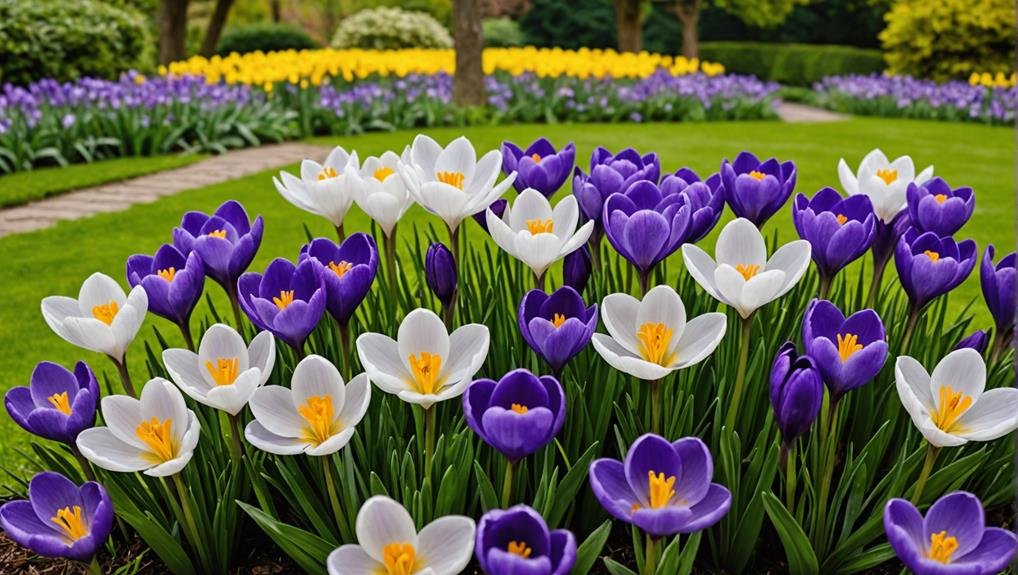
Boasting a spectrum of colors, Crocus flowers offer an extensive palette that includes yellow, purple, white, and even striped combinations. These vibrant hues make Crocus a versatile choice for wedding arrangements, allowing for a wide range of color combinations and floral symbolism. Whether opting for the delicate lavender hues or the striking bi-color blooms, Crocus flowers can enhance any bridal bouquet or centerpiece with their unique arrangements.
Here is a quick overview of the available color varieties and their potential uses:
| Color Varieties | Potential Uses |
|---|---|
| Yellow | Adds a cheerful and sunny touch to bouquets and arrangements. |
| Purple | Often used to symbolize nobility and elegance in floral designs. |
| White | Ideal for creating a classic and timeless look in wedding decor. |
Some Crocus varieties also feature shades of blue, pink, and orange, offering even more options for bouquet inspiration. The availability of these colors means that Crocus can be incorporated into any wedding theme, from traditional to contemporary. Their diverse color palette enables couples to select flowers that perfectly match their personal style and wedding palette, ensuring that their floral arrangements are as unique and memorable as their special day.
Latin Name and Taxonomy
Understanding the botanical identity of Crocus involves exploring its Latin name, Crocus sativus, which places it within the Iridaceae family. This flowering plant encompasses over 80 species, renowned for their vibrant petals ranging from yellow and mauve to white.
The term ‘Crocus’ is derived from the Latin ‘crocatus,’ alluding to saffron yellow, a reference to the valuable spice derived from the stigmas of Crocus sativus.
Crocus sativus has been commercially significant since medieval times, primarily due to its saffron, the most expensive spice globally. Its cultivation and use extend beyond culinary applications; historical symbolism and medicinal properties also highlight its importance. Saffron has been used in traditional medicine for various ailments, contributing to its revered status.
However, conservation efforts are crucial for some Crocus species, as they face threats from habitat loss. These threatened species underscore the need for responsible cultivation and care to guarantee their survival.
Geographical Origins

Southern Europe, the Middle East, and parts of Asia serve as the native habitats for the diverse species of Crocus. These regions provide the well-drained soil and moderate temperatures that are essential for the plant’s growth.
The Crocus sativus variety, known for its saffron production, is primarily cultivated in Iran, Spain, Kashmir, and Greece, highlighting its widespread cultural and economic significance.
Crocus species thrive in various ecological niches, ranging from alpine meadows to coastal regions. This wide range of habitats underscores their remarkable climate adaptation abilities, allowing them to flourish in diverse environmental conditions. The global distribution of Crocus reflects their versatility and resilience.
The ecological impact of Crocus is significant, contributing to local biodiversity. Conservation efforts are increasingly important to protect these species from habitat loss and environmental changes.
Key points to keep in mind include:
- Ecological Impact: Crocus contributes to the biodiversity of its native regions.
- Climate Adaptation: The plant’s ability to thrive in different climates enhances its global distribution.
- Conservation Efforts: Protecting natural habitats is essential to preserve Crocus species for future generations.
Understanding the geographical origins of Crocus enriches our appreciation for this versatile and culturally significant flower.
Season Availability
Crocus flowers are typically available from late winter to early spring, making them one of the earliest floral options for spring weddings. Their peak blooming period ranges from February to April, depending on the species and variety. This early availability allows couples to incorporate these vibrant blooms into their wedding floral arrangements at a time when other flowers may not yet be in season.
The Crocus’s cheerful appearance and its Crocus symbolism of new beginnings and happiness make it an ideal choice for wedding ceremonies that aim to celebrate fresh starts and joyous unions. Whether used in a Crocus bouquet or as part of a larger seasonal decor theme, these flowers can add a bright, uplifting touch to any event.
When planning a wedding during these months, it’s essential to take into account the season availability of Crocus flowers to make sure they are in full bloom for your special day. Their early blooming period can be particularly advantageous for couples seeking to infuse their wedding with the first hints of spring’s renewal. Including Crocus flowers in your floral arrangements can create a stunning visual impact while aligning perfectly with the symbolic essence of new beginnings.
Growing Conditions
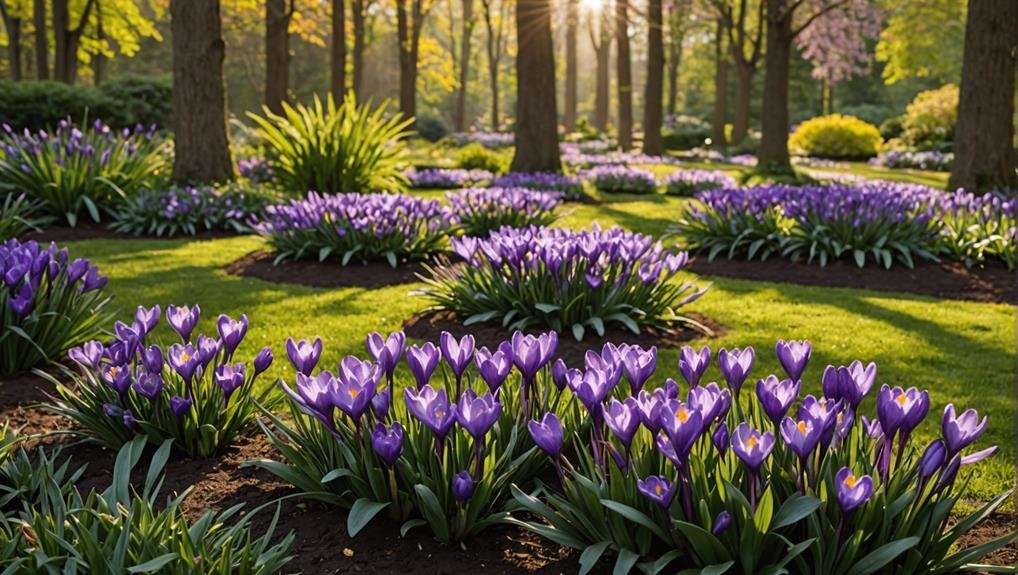
Ideal growing conditions for Crocus flowers include well-drained soil and exposure to full sun or partial shade. These circumstances ensure that the crocus bulbs prosper, making them an excellent option for adding a touch of sophistication to wedding settings. Understanding their soil preferences and sunlight needs is essential for successful growth.
Crocus flowers prefer cooler climates and show remarkable frost tolerance, allowing them to endure low temperatures.
When planting crocus bulbs, it is vital to consider the planting depth, which should be between 3-4 inches. Moreover, spacing the bulbs 2-3 inches apart is recommended to guarantee healthy growth and sufficient space for development.
Here are three key points to keep in mind:
Soil Preferences and Sunlight Requirements:
- Crocus thrives in well-drained soil.
- They need full sun to partial shade for optimal growth
Frost Tolerance:
- These flowers are well-suited for cooler climates and can endure frost conditions.
Planting Depth:
- Plant the bulbs 3-4 inches deep and space them 2-3 inches apart for best results.
Crocus flowers require minimal maintenance once established, making them a practical and gorgeous choice for wedding floral arrangements. Whether grown in pots or borders, they effortlessly enhance any wedding setting.
Cultural Significance
Throughout history, the cultural significance of Crocus flowers has been deeply rooted in various traditions and beliefs, particularly in the context of weddings. In ancient Greece, Crocus flowers were closely associated with the gods and were believed to bring good luck and prosperity to wedding celebrations. This connection to divine favor added to their allure as a wedding flower.
The symbolic meanings of Crocus flowers further enhance their appeal in matrimonial ceremonies. They symbolize happiness, joy, and new beginnings, making them a fitting choice for marking the start of a couple’s life together. Their vibrant colors, such as yellow, mauve, and white, not only add a cheerful and romantic touch but also signify purity, love, and fidelity—values cherished in any marriage.
Historical traditions often see Crocus flowers featured prominently in wedding folklore. For instance, some superstitions suggest that including Crocus flowers in wedding decor can invite a touch of elegance and sophistication, enhancing the overall ambiance of the celebration.
These traditions and beliefs underscore the enduring cultural resonance of Crocus flowers, making them a timeless choice for couples seeking to imbue their special day with deep, meaningful symbolism.
Typical Use in Weddings
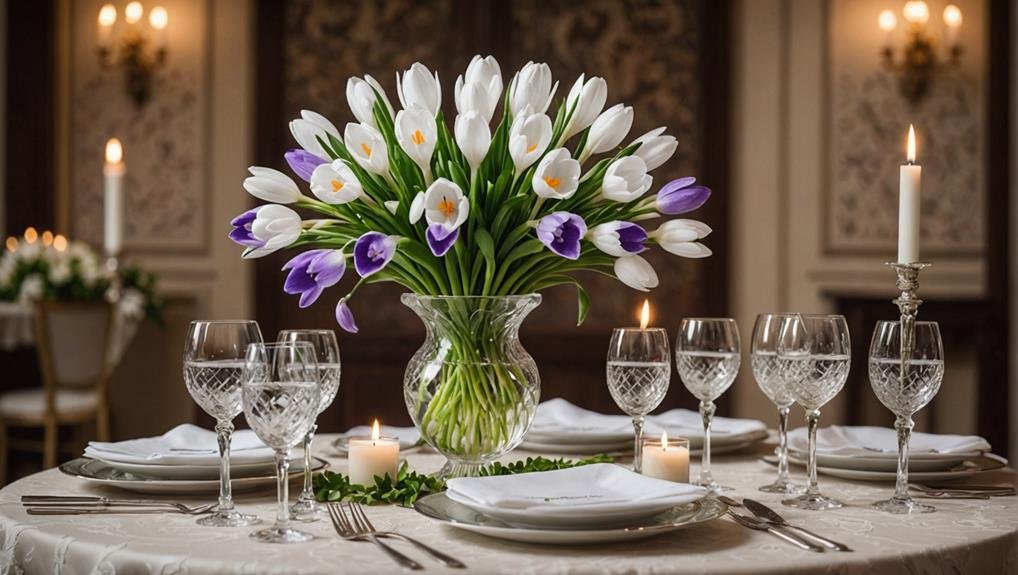
While Crocus flowers hold significant cultural meaning, their practical application in weddings is often limited due to their small size and delicate nature. These charming blooms are typically more suited for home gardens and landscaping rather than for elaborate wedding bouquets or floral arrangements. However, they can still serve a role in more intimate, DIY-focused settings where their subtle beauty can be appreciated.
Incorporating Crocus flowers in weddings often requires a creative approach. Here are some unique alternatives and DIY bouquet ideas to contemplate:
- Accent Flowers: Use Crocus flowers as accent pieces in larger arrangements to add a touch of elegance without overwhelming the display.
- Boutonnieres and Corsages: Their small size makes Crocus flowers ideal for boutonnieres and corsages, providing a delicate and charming detail.
- Table Centerpieces: Incorporate Crocus blooms into smaller, minimalist table centerpieces for a subtle yet sophisticated look.
Given their limited blooming season and color range, Crocus flowers may not be the centerpiece of your wedding decor, but they can certainly add a unique charm to smaller elements. For couples seeking distinctive and personal touches, these blooms offer a delightful way to enhance DIY projects and bespoke arrangements.
Alternative Flower Types
For couples seeking versatile and vibrant options, alternative flower types such as daffodils, tulips, and hyacinths offer a beautiful array of choices for wedding arrangements. Daffodils, known for their distinctive trumpet-shaped blooms, come in a variety of colors including yellow, white, and orange. These flowers add a touch of brightness and cheer to any wedding setting. Daffodil arrangements can be particularly striking as centerpieces or accent bouquets, providing a lively and fresh appearance.
Tulips, celebrated for their wide range of colors and shapes, are a popular choice for wedding flowers. From classic single blooms to intricate double petals, tulip bouquets can be tailored to fit any wedding theme or color palette. Their elegant simplicity makes them suitable for both modern and traditional ceremonies.
Hyacinths, with their fragrant and dense clusters of small, bell-shaped blooms, offer another excellent alternative. Available in shades of pink, purple, white, and blue, they introduce rich texture and a delightful scent to floral arrangements. Incorporating these flowers into wedding decor can create a visually and aromatically pleasing experience.
